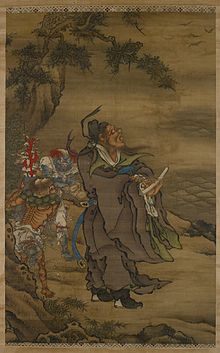Zhong Kui
This article needs additional citations for verification. (December 2013) |


Zhong Kui (Chinese: 鍾馗; pinyin: Zhōng Kuí; Wade–Giles: Chung Kwei; Japanese pronunciation: Shōki) is a figure of Chinese mythology. Traditionally regarded as a vanquisher of ghosts and evil beings, and reputedly able to command 80,000 demons, his image is often painted on household gates as a guardian spirit, as well as in places of business where high-value goods are involved.
Becoming the king of ghosts
According to folklore, Zhong Kui travelled with Du Ping (杜平), a friend from his hometown, to take part in the imperial examinations at the capital. Though Zhong achieved top honours in the exams, his title of "zhuangyuan" was stripped by the emperor because of his disfigured appearance. In anger, Zhong Kui committed suicide upon the palace steps by hurling himself against the palace gate until his head was broken. Du Ping buried him. During his judgment, the Hell King saw potential in Zhong. Intelligent enough to score top honors in the imperial examinations, but damned to hell because he committed suicide. The Hell King (judge) then gave him the title, as king of ghosts, forever to hunt, capture, maintain and order ghosts. After Zhong became king of ghosts in Hell, he returned to his hometown on Chinese New Year's Eve. To repay Du Ping's kindness, Zhong Kui gave his younger sister in marriage to Du.[1]
-
A detail of "Shōki zu" (Shōki striding), by Okumura Masanobu in pillar print format, c. 1741–1751.
-
An ink painting of Zhong Kui by the Shunzhi Emperor (r. 1643–1661) of the Qing dynasty, kept at the Palace Museum in Beijing.
Popularization in later dynasties

Zhong Kui's popularity in folklore can be traced to the reign of Emperor Xuanzong of Tang China (712 to 756). According to Song Dynasty sources, once the Emperor Xuanzong was gravely ill. He had a dream in which he saw two ghosts. The smaller of the ghosts stole a purse from imperial consort Yang Guifei and a flute belonging to the emperor. The larger ghost, wearing the hat of an official, captured the smaller ghost, tore out his eye and ate it. He then introduced himself as Zhong Kui. He said that he had sworn to rid the empire of evil. When the emperor awoke, he had recovered from his illness. So he commissioned the court painter Wu Daozi to produce an image of Zhong Kui to show to the officials. This was highly influential to later representations of Zhong.[2]
In popular culture
- Zhong Kui is the main character in the TV series "Heavenly Ghost Catcher"

- Zhong Kui is a playable character in the game "SMITE", where his title is "The Demon Queller".
- Zhong Kui is the main character in the movie "Zhong Kui: Snow Girl and the Dark Crystal"
- Along with many other famous fictional characters, Zhong Kui appears in the infamous 1977 Bruceploitation film, The Dragon Lives Again.
See also
References
- ^ Nagendra Kumar Singh (1997). International encyclopaedia of Buddhism: India [11]. Anmol Publications. pp. 1372–1374. ISBN 978-81-7488-156-4. Retrieved 7 June 2013.
- ^ Richard Von Glahn (2004). The Sinister Way: The Divine and the Demonic in Chinese Religious Culture. University of California Press. pp. 122–128. ISBN 978-0-520-92877-0. Retrieved 7 June 2013.


